
Kosovo
For a full scale picture, please click on the picture shown !

All the pictures on this page are from or taken by Mr Markku Salo, who served as a NATO troop
peacekeeper in Kosovo and while doing so, also took part in the training of Albanians as new train operators in the state of Kosovo.
A lot of used train rolling stock equipment, often in desolate state, was scraped together from all parts of Europe to try to get a
stable train service up and running again.
This locomotive is very special indeed. Here we see it in the colours of the Norwegian national railways NSB. It is a Nohab diesel
of the Norwegian class Di3b from the 1950s. This individual was built by Nohab in Sweden for the Finnish state railways VR as VR
indicated it wanted to buy 40 of these locomotives. This one was in test use in Finland for quite some time and it was well liked,
but in the end VR never got the permission to use so much foreign currency to buy the Nohabs (It was still the hard times shortly
after the war) and the deal was cancelled. Finally the company Nohab managed to sell this machine to the Norwegian NSB which had
already earlier bought a series of almost similar Nohabs.
NSB in Norway took all "Nohab roundnoses" out of service in the year 2000 (or right after) and sold four of them cheaply to the United
Nations. UN put them in service in Kosovo and the "Finnish" no. 643 happened to be one of them.
Picture from Polje station in Kosovo 2004 by Markku Salo.

Another Nohab "roundnose" in Norwegian NSB colours at Polje station in Kosovo.
Picture in 2004 by Markku Salo.
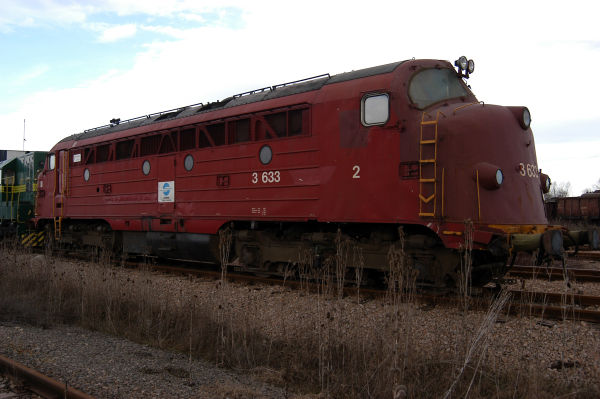
A third Norwegian Di3 Nohab at Polje station in Kosovo. Note the "UNMK Railways" sticker at the side. At that time it was the United
Nations which was running railway systems in Kosovo. Picture in 2004 by Markku Salo.
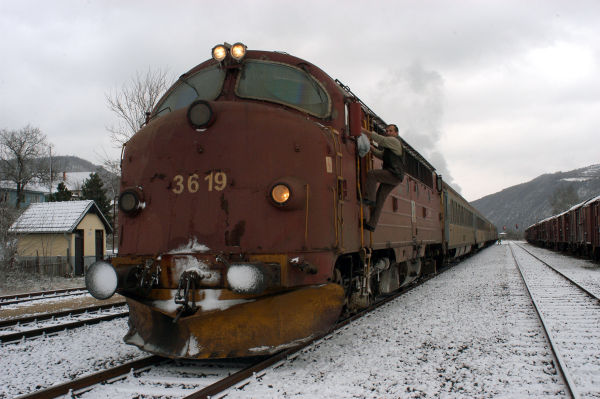
The last one of the four Norwegian Di3 Nohabs, the no. 619 is seen here at the station of Mitrovica. The coaches behind are probably
originally Czech or Slovakian. Picture in 2004 by Markku Salo.
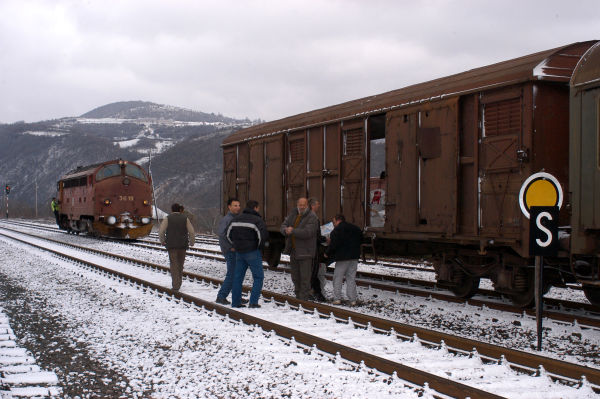
The same Nohab no. 619 at Mitrovica in 2004. In those days the UN/Kosovo railways could still run to Mitrovica. But as Kosovo
declared independence from Serbia in 2008, within weeks the Serbian railways ŽS unilaterally confiscated all railroads, all the
infrastructure and even the railway personnel in northern Kosovo. Since 2009 ŽS has been operating direct trains from Belgrad to
Mitrovica. Serbia still considers Kosovo to be part of its own territory. Nowadays all train traffic between Zvečan and Mitrovica
is suspended. Picture in Mitrovica in 2004 by Markku Salo.
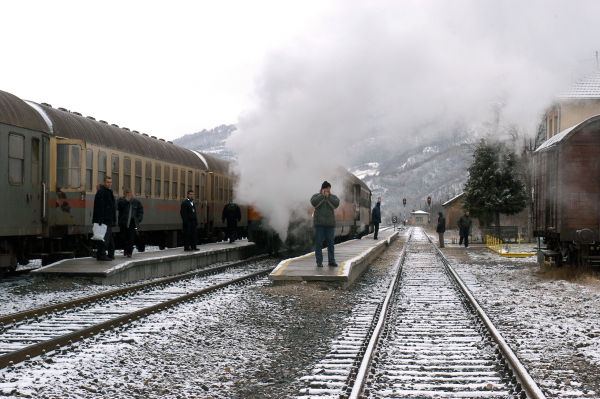
The station of Mitrovica in the north of Kosovo in 2004. Nowadays Kosovarian trains cannot go there any more or otherwise they
would also run the risk of being confiscated by the Serbian railroads. The population in that part of Kosovo is mainly Serbian.
Picture in Mitrovica in 2004 by Markku Salo.
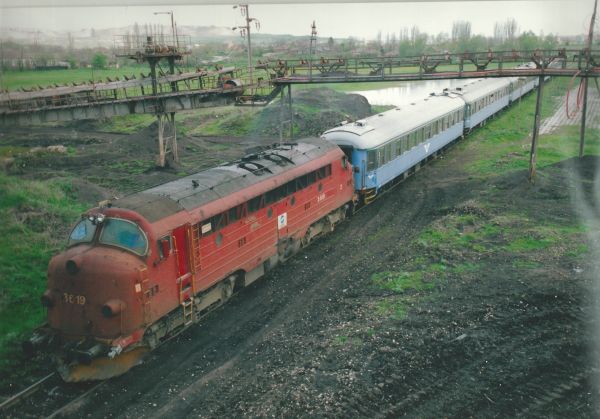
Nohab no. 619 with Swedish old express train coaches on the way as an InterCity from Pristina to Mitrovica in 2004, seen here
near the power plant of Obilić. Note the classic 1960s style Swedish SJ coaches. The one at the front still has even the SJ logo
on its side. Picture in 2004 in Obilić by Markku Salo.
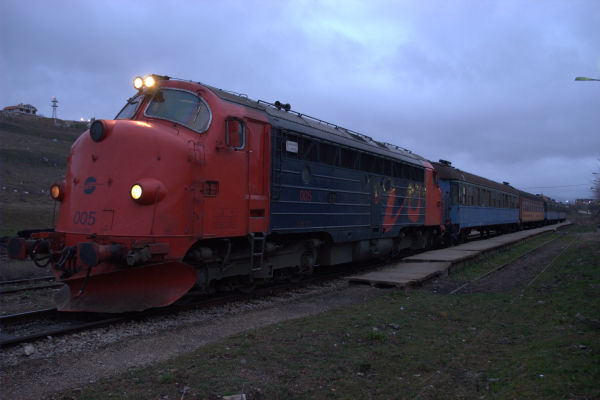
One of the Nohab diesels in Pristina 5. March 2008. It has been renumbered and repainted to a painting scheme which resembles the
paintings of Nohabs of the Danish railways. This one is the former Norwegian Di3 no. 619. Of the coaches behind the locomotive,
the three light blue ones are typical 1960s express train wagons of the Swedish state railways SJ. Picture in Pristina 5.3.2008 by
Markku Salo.
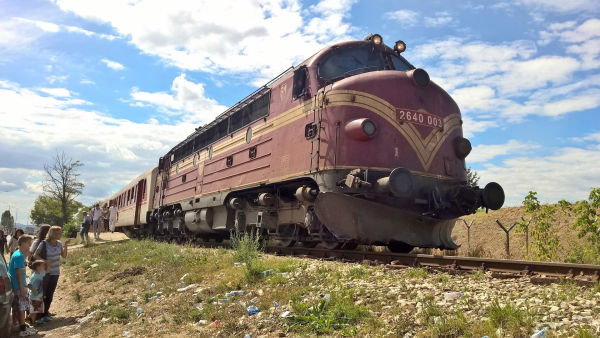
One of the Nohabs with an InterCity train in Pristina in 2015. This locomotive is the ex NSB Di3b no. 641. The coaches behind it
are so called Schlieren coaches which have been bought from Austria. Previously they were used in regional express trains of the
Austrian ÖBB. They were built 1977-1980 and they were sold to Kosovo 2009/2011. Picture in Pristina by Markku Salo.
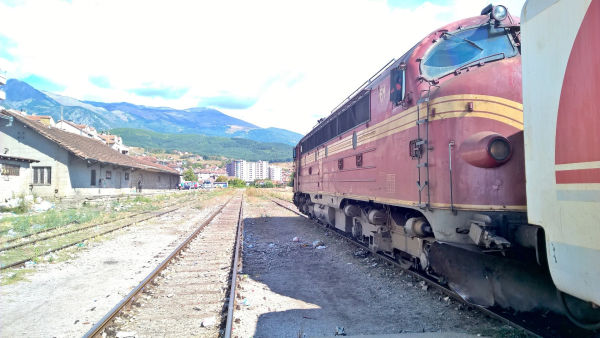
One of the Nohabs, the former Norwegian Di3b 641 is here arriving at the station of Prizren. The coach is one of the formerly Austrian
Schlierenwagons. Picture in 2015 by Markku Salo.
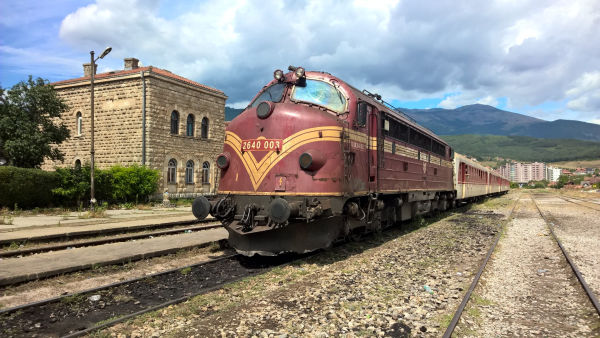
Same train as in the picture above, but seen from the other direction. Former NSB Di3 641 with Austrian Schlierenwagons is forming an
InterCity service. Picture in Prizren in 2015 by Markku Salo.
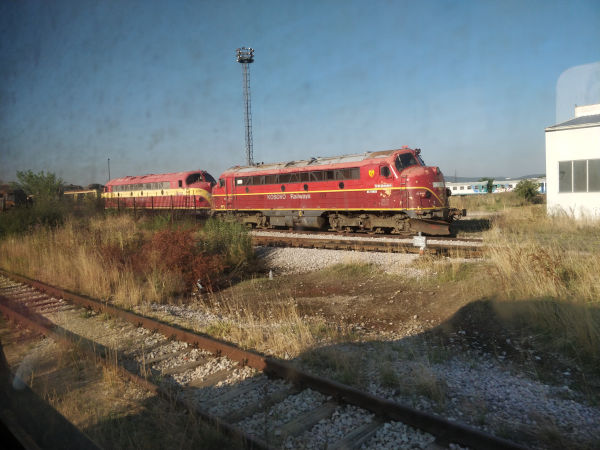
Two of the same old Di3 Nohab diesels seen in 2019. Now these locomotives seem to be already in fairly bad shape.
Picture from Kosovo Polje 13.8.2019 by Markku Salo.
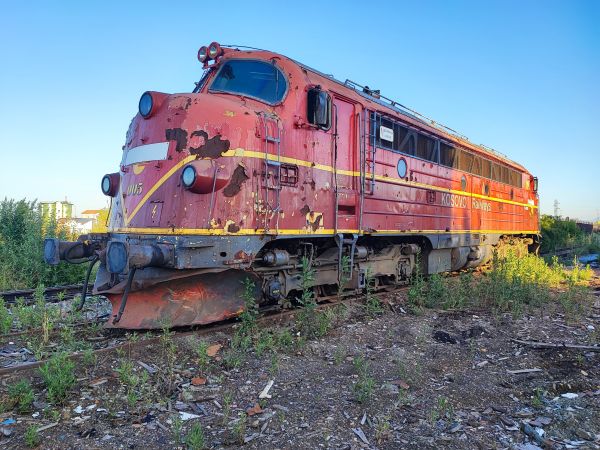
The end of a long journey from the Arictic circle to Kosovo. Norwegian Railways NSB Di3 no.619 alias Kosovo Railroads 005 was the very last
one of the famous Nohab roundnose locomotives which were used in Kosovo after their long life in Norway. This is the final resting place of the
very last one of them, now known as Kosovo Railways 005. This picture was taken by Markku Salo at Fushe Kosova, where several railraods cross
not far away from Prishtina. As you can see from earlier pictures shown above, Markku worked also as a driver for many of these NOHAB roundnoses
including this one while he was in Kosovo serving for KFOR on behalf of the NATO.
Picture from Fushe Kosova 16.6.2022 by Markku Salo.
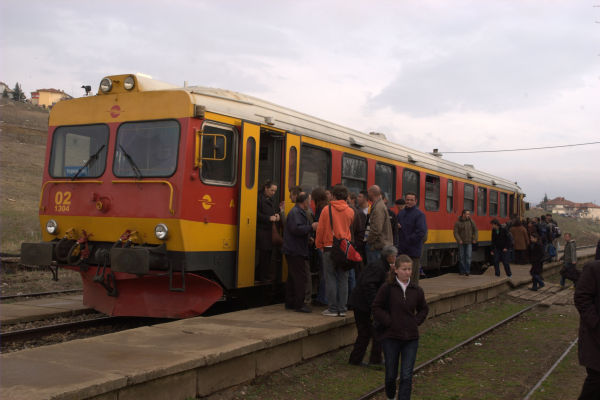
A regional service train has just arrived from Peć to Pristina. The railbus is a former Swedish class Y1. Four of these railbuses
(numbers 1281, 1304, 1306, 1313) were sold in 2007 to Kosovo for local trains between Pristina and Peć. The railcars were renumbered
01 to 04 but for a while they still carried their old Swedish numbers below the new numbers as well. These trains were built 1979-81.
Technically they are Fiat railbuses and are based on the Italian FS type ALn 668. Some of them were built in Italy by Fiat and yet
others in Sweden by Kalmar Verkstad. They soon got in Sweden the nickname of "pizzarockets" due to their Italian origin. The Fiat engines
however were so lousy and underpowered that they were later replaced by Swedish Volvo truck engines with much more power, after which these Y1
railbuses became really good and reliable trains. There are still in 2017 some of them in use in Sweden as well. Sweden sold a large number
of its Y1s to Yugoslavia already before Yugoslavia broke up. As a result, these trains can be seen all over from Slovenia in the north to
Macedonia in the south. Picture in Pristina 5.3.2008 by Markku Salo.
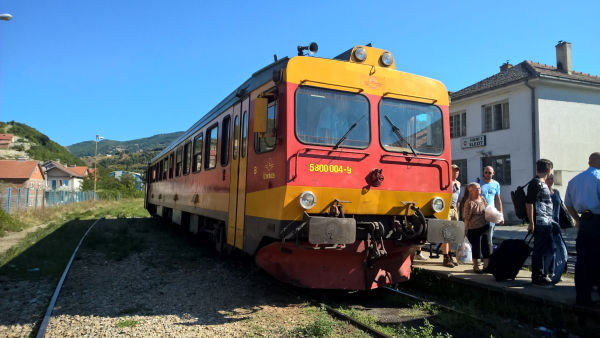
One of the same ex Swedish Y1 railbuses as in the picture above, but now seen at the Hani i Elezit station in 2015. In the meantime the
train numbering has been changed and old Swedish numbers have disappeared. Note also the "Trainkos" logo at the side of the railbus. This
is the current name of the train operator in Kosovo. The old United Nations UNMK railways logo at the front of the railbus has been scraped
(partly) away.
Trainkos has also three of the old Italian ALn668 railbuses dating back to 1966, which are technically very similar to the Swedish class Y1
and actually their precursors, but they have been taken out of service now that the better Y1s with the more reliable Volvo engines are
available.
Picture at Hani i Elezit (Elez Han) station 2015 by Markku Salo.
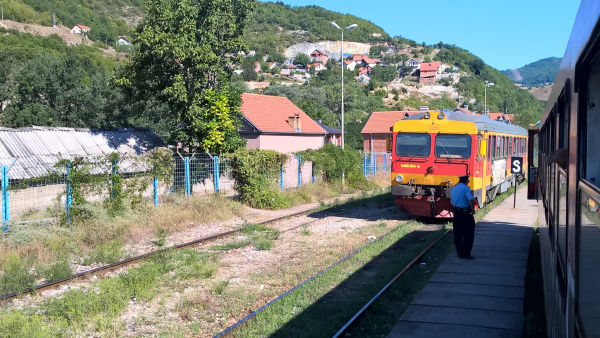
Two trains meeting at the Hani i Elezit station at the border to Macedonia, the one on the left being the same Y1 railbus as in the picture
above. Trainkos has nowadays three types of passenger trains: local trains, "Freedom of movement" trains and InterCity trains. The InterCity
trains are most often run by Nohabs and Swedish formerly SJ express train coaches, whereas the Freedom of movement and local services are
typically run by the Y1 railbuses. The Y1s operate all trains between Pristina and Peć and are also sometimes - like here - used on the
line to Hani i Elezit. Picture at Hani i Elezit (Elez Han) station 2015 by Markku Salo.
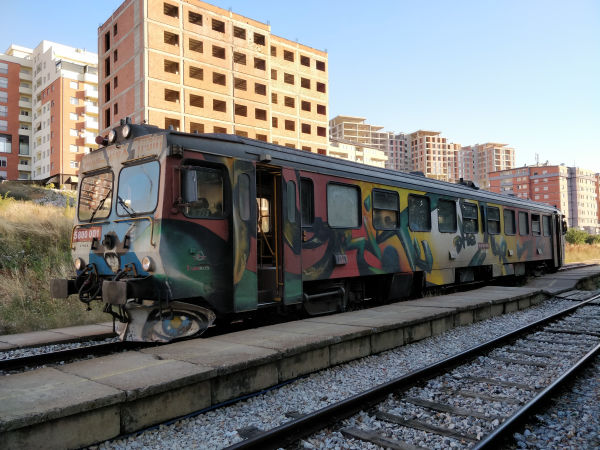
Graffiti damage is a real problem not only in Kosovo, but throughout the Balkan area. Here TrainKos has solved the issue in an artistic way by getting some
real good artist to paint the whole train. This railbus is a former Swedish class Y1 train, in Kosovo called class 5800.
Picture from Prishtina 13.8.2019 by Markku Salo.
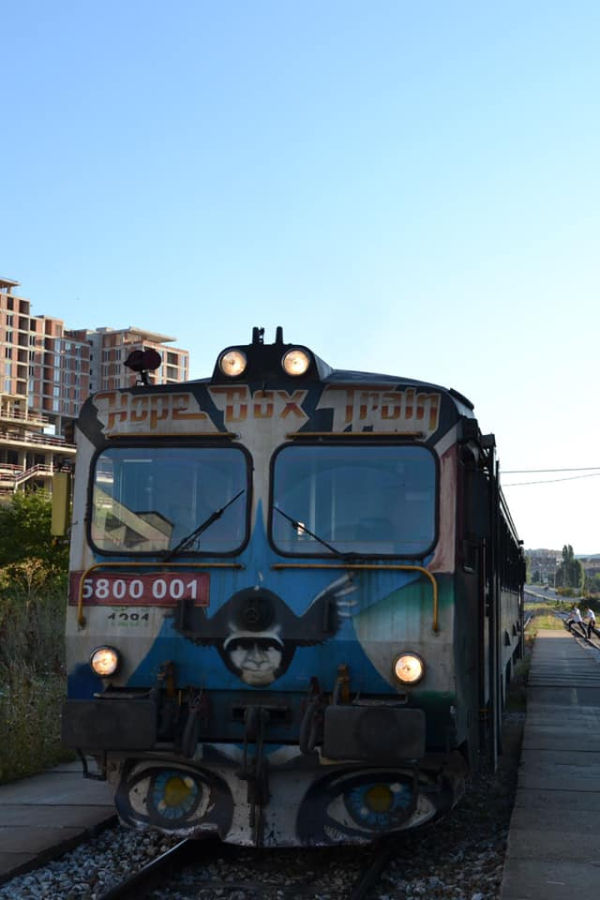
The same railbus as shown above but seen from its front.
Picture from Prishtina 13.8.2019 by Mirjam Heinonen.
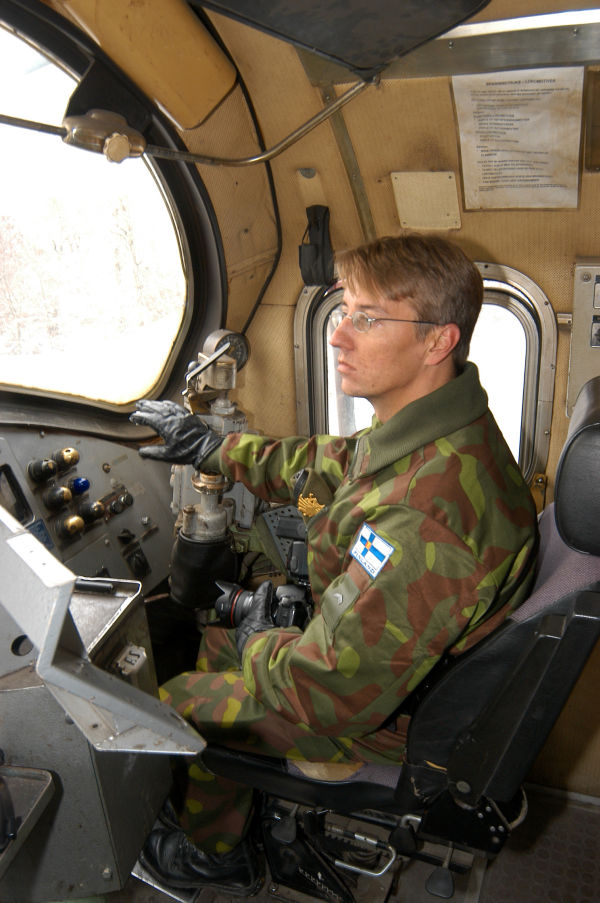
During the NATO peacekeeping effort used trains were brought into Kosovo from all over and the peacekeepers also helped the Kosovo-Albanians
to start using them. In this picture Finnish peacekeeping soldier Markku Salo himself is driving a Norwegian Nohab. Markku has told us that
occasionally there was a crowded feeling in the locomotive cabs as there could have been one Serbian teaching one or two Kosovo-Albanians
plus one or two peacekeepers in the locomotive cab to keep potential hostilities at bay.
Note the paper attached to the wall, "Branninstruktii, Lokomotiver", instructions what to do in case of a locomotive fire. I doubt the Kosovo-
Albanians read fluently Norwegian ;-D
Picture of Markku Salo in 2004.
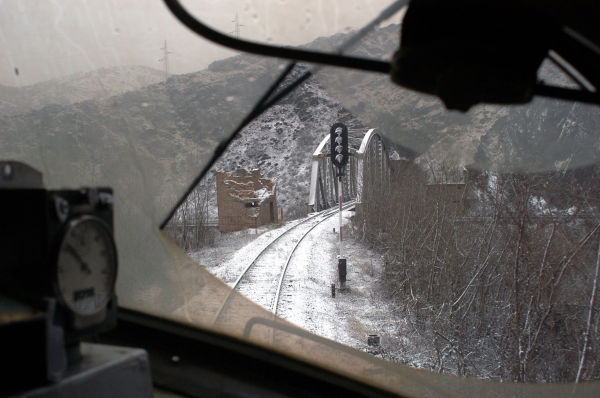
A view from the driver's seat of a Nohab. Picture by Markku Salo in 2004.
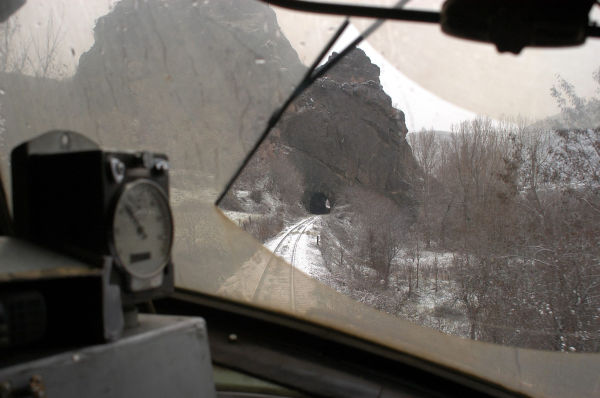
Kosovo is a mountainous land. A train driver has very beautiful views. Picture by Markku Salo in 2004.

A freight train is approaching the brown coal operated power plant of Obilić. Picture by Markku Salo in 2004.

A driver's view while approaching the Kosovo Polje station. Picture by Markku Salo in 2004.
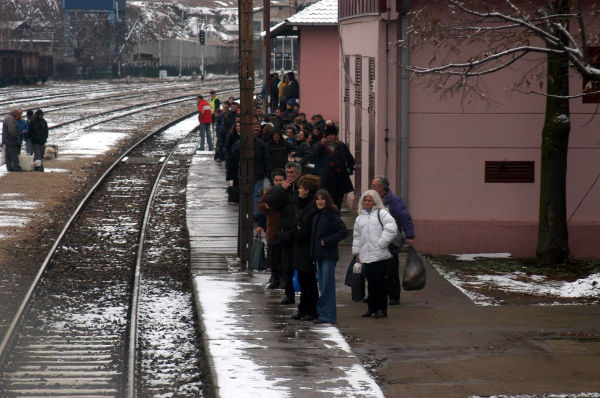
A Nohab diesel leading a passenger train is approaching a small station full of waiting
passengers. Picture by Markku Salo in 2004.
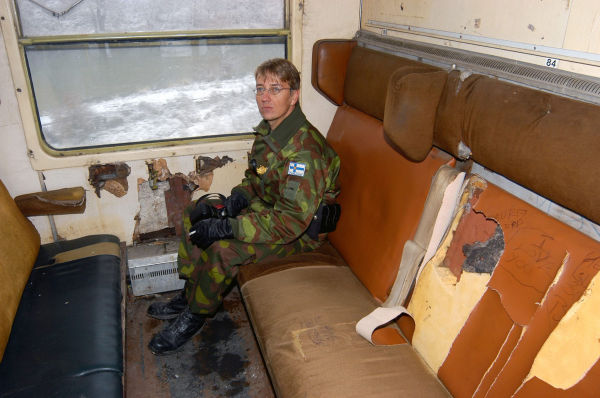
Passenger comfort in second class in war-torn Kosovo in 2004 was not quite up to Western
standards. Picture of Markku Salo in 2004.
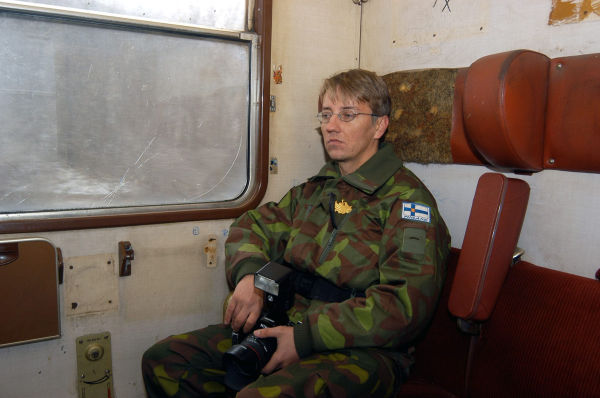
NATO peacekeeper corporal Salo in another ex-Yugoslavian second class coach. Picture of Markku Salo in 2004.
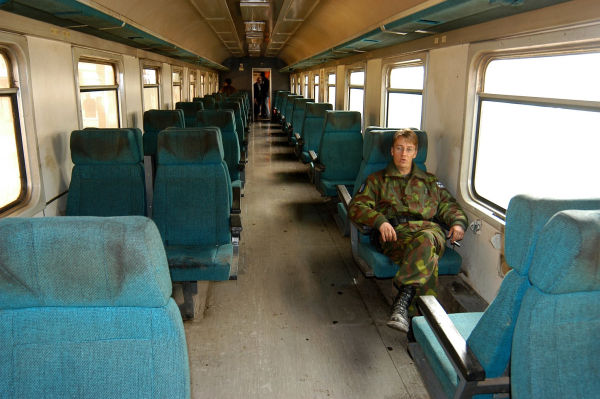
Ex-Yugoslavian first class in Kosovo in 2004. Picture of Markku Salo in 2004.
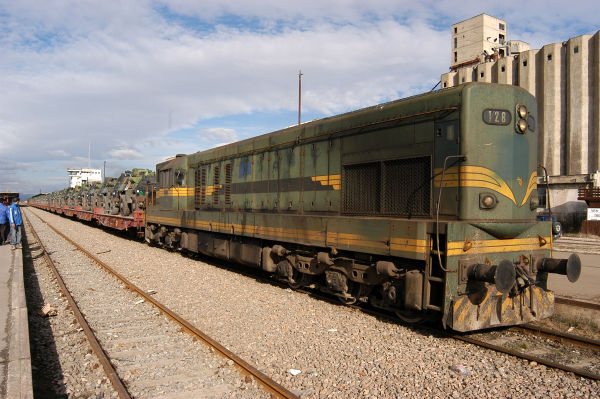
Ex-Yugoslavian EMD G16 (class JŽ 661) locomotive hauling French made "VAB" armored vehicles used by the NATO peacekeepers. This locomotive
type is an old US type built by General Motors Electro-Motive Division 1959-1972. President Kennedy gave pres. Tito's Yugoslavia a licence
to build these machines and large numbers of them were built since the 1970s. The machine was known in Yugoslavia as JŽ class 661. Here we
see the machine in original JŽ paintings but with the old JŽ logos covered with paint. Trainkos has three of these, but only one was in working
order in June 2017.
Picture by Markku Salo in Kosovo Polje in 2004.
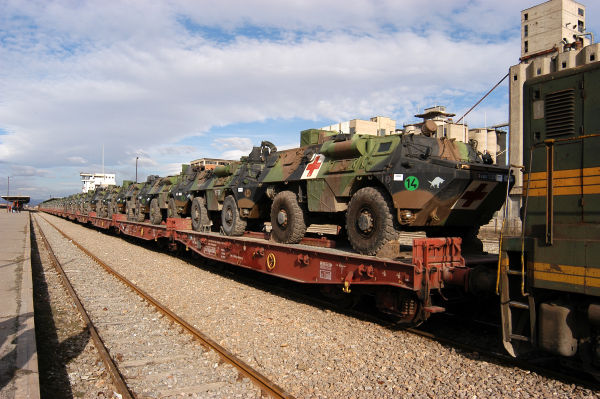
French made "VAB" (Véhicule de l'Avant Blindé) is a 4x4 or 6x6 wheeled amhibious armored personnel carrier vehicle, motorised with a French Renault engine.
Picture by Markku Salo in Kosovo Polje in 2004.
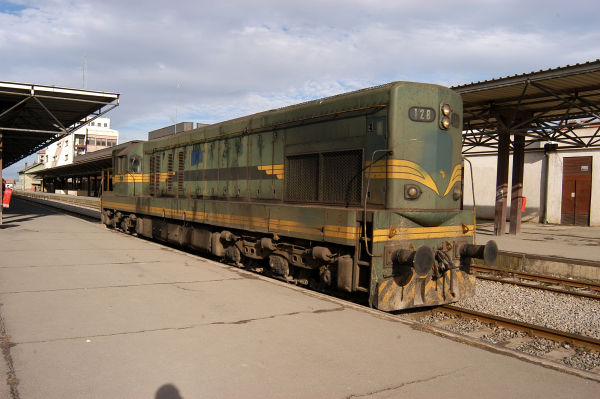
Another view of the EMD G16 diesel locomotive. The machine weighs 112 tons, has a top speed of 124 km/h and a power rating of 1435 kW.
It has a 16 cylinder two-stroke diesel engine and a fuel tank of 3407 litres. Transmission is dieselelectric.
Picture by Markku Salo in Kosovo Polje in 2004.
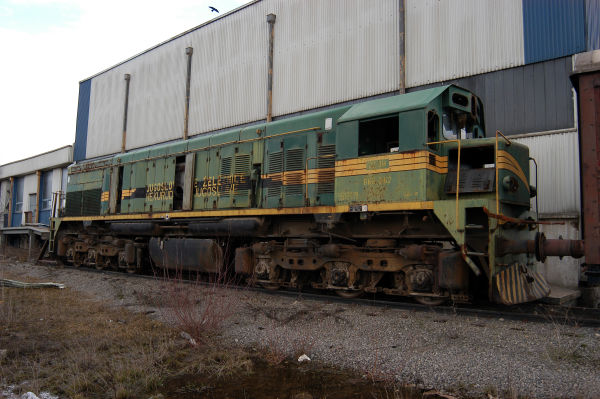
This diesel locomotive is - or rather was - a Yugoslav railways class 664 machine. It was a General Motors Electro-Motive Division
export model EMD G26. 65 machines were built by EMD in USA and exported to Yugoslavia and the company Đuro Đaković in Croatia built 20 more there.
When Yugoslavia broke up, the machines were divided. Croatia got 60 locomotives, Slovenia 20 and Serbia 5. None was left in working order
in Kosovo. This was one of the Serbian machines. Picture by Markku Salo in Kosovo Polje in 2004.
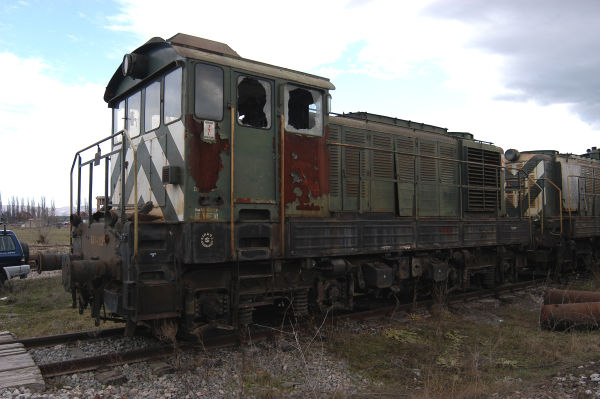
This poor machine used to be a Yugoslav railways class 641 machine. It was made in Hungary by Ganz-Mavag 1960-1985 and it is the same machine
type which in Hungary is known as MAV class M44 and in Poland as PKP class SM41. 31 locomotives were delivered to Yugoslav railways Belgrade section
which later became Serbian railways. Picture by Markku Salo in Kosovo Polje in 2004.
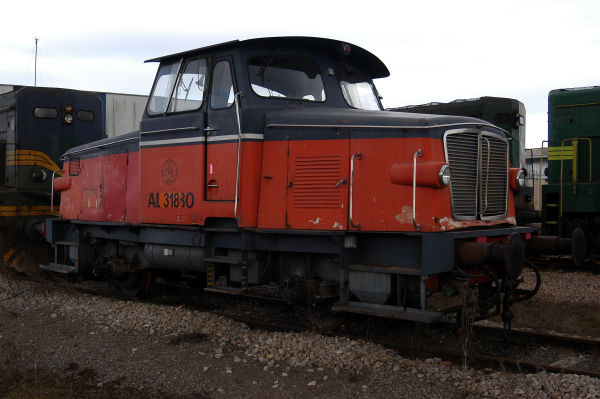
To get train traffic operational again in Kosovo the United Nations collected whatever railroad rolling stock they could. This one is a
class Z65 light shunter of the Swedish state railways SJ. It is no longer listed as available for the Trainkos, so apparently it has been
scrapped by now. United Nations did not actually run the peacekeeping efforts, but they had a lot of civilian workers in Kosovo and they also provided
policemen until enough Kosovo-Albanian police forces could be trained. UN owned most of the trains during and right after the crisis.
Picture by Markku Salo in Kosovo Polje in 2004.
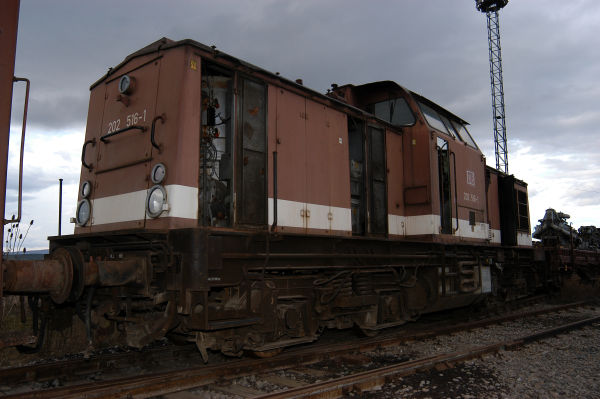
This one is a class V100 diesel locomotive of the former DR of DDR, here still in the paintings of former East Germany, but already with the
western DB logo and with DB's new class number 202 for it. These machines are still in 2017 quite common not only in Germany, but in the
neighbouring countries as well. But the 2017 listing of Trainkos locomotives does not mention this, so we have to assume that it has been
scrapped by now. Picture by Markku Salo in Kosovo Polje in 2004.
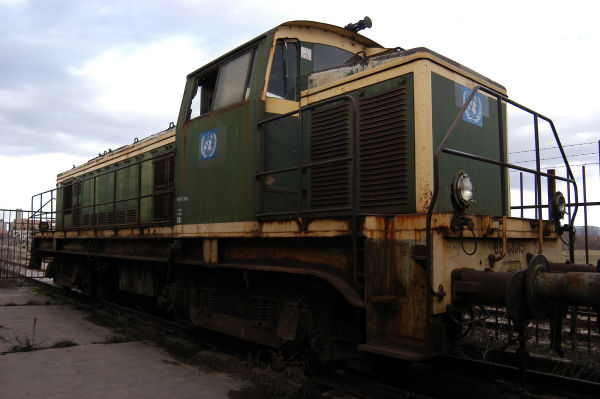
This machine with the blue United Nations stickers was already in 2004 in a bad shape. It used to be a French state railways SNCF class
BB63000 machine. They were built in France by Brisonneau et Lotz and Sulzer 1953-64. It was a light shunter with a max speed of 90 km/h.
Picture by Markku Salo in Kosovo Polje in 2004.
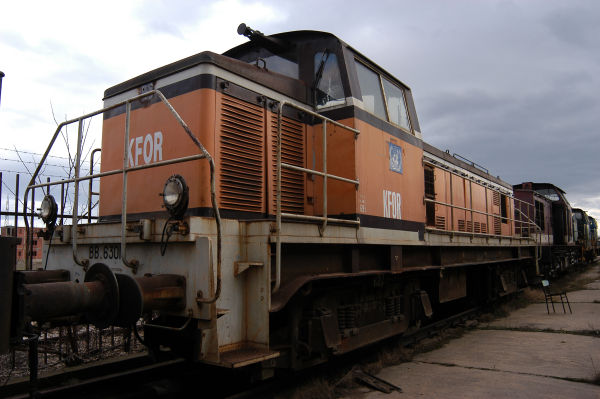
Another French SNCF class BB63000 machine, but this one in a better condition and with a newer French SNCF painting. None of these machines
are left in working order in Kosovo in 2017. Picture by Markku Salo in Kosovo Polje in 2004.
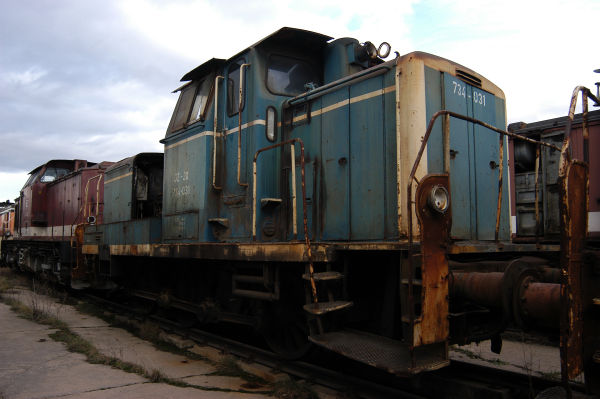
This rusted machine was a West German V60, currently DB classes 363-365, formerly DB 360, but here marked as Yugoslav railways class 734.
It has the paintings that DB used in the 1970s. They were built in West Germany around 1955 and Yugoslav railways bought 30 used machines
in 1985. It looks like this poor machine has not received much attention since then. The type is still quite common in Germany.
Picture by Markku Salo in Kosovo Polje in 2004.

There are still in 2017 two steam locomotives operational in daily work. They have two tasks: Bringing brown coal from Kastriot coal mines to the Obilić
power plant nearby and bringing coal wagons every other day to the Obilić station, from where Trainkos diesels take the wagons to the NewCoFerronikeli
plant near Glogovac. The steam engines are operated by the coal mine. The Jugoslovenske Železnice (JŽ; Yugoslavian Railways) class 62
was a class formed of 106 ex-United States Army Transportation Corps S100 Class 0-6-0T steam locomotives, surplus after the Second World War,
plus about 90 similar examples built by Đuro Đaković of Slavonski Brod, Croatia between 1952 and 1961. Picture in Obilić in 2004 by Markku Salo.

